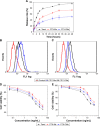Sodium cholate-enhanced polymeric micelle system for tumor-targeting delivery of paclitaxel
- PMID: 29263668
- PMCID: PMC5732553
- DOI: 10.2147/IJN.S150196
Sodium cholate-enhanced polymeric micelle system for tumor-targeting delivery of paclitaxel
Abstract
Purpose: Polymeric micelles are attractive nanocarriers for tumor-targeted delivery of paclitaxel (PTX). High antitumor efficacy and low toxicity require that PTX mainly accumulated in tumors with little drug exposure to normal tissues. However, many PTX-loaded micelle formulations suffer from low stability, fast drug release, and lack of tumor-targeting capability in the circulation. To overcome these challenges, we developed a micellar formulation that consists of sodium cholate (NaC) and monomethoxy poly (ethylene glycol)-block-poly (d,l-lactide) (mPEG-PDLLA).
Methods: PTX-loaded NaC-mPEG-PDLLA micelles (PTX-CMs) and PTX-loaded mPEG-PDLLA micelles (PTX-Ms) were formulated, and their characteristics, particle size, surface morphology, release behavior in vitro, pharmacokinetics and in vivo biodistributions were researched. In vitro and in vivo tumor inhibition effects were systematically investigated. Furthermore, the hemolysis and acute toxicity of PTX-CMs were also evaluated.
Results: The size of PTX-CMs was 53.61±0.75 nm and the ζ-potential was -19.73±0.68 mV. PTX was released much slower from PTX-CMs than PTX-Ms in vitro. Compared with PTX-Ms, the cellular uptake of PTX-CMs was significantly reduced in macrophages and significantly increased in human cancer cells, and therefore, PTX-CMs showed strong growth inhibitory effects on human cancer cells. In vivo, the plasma AUC0-t of PTX-CMs was 1.8-fold higher than that of PTX-Ms, and 5.2-fold higher than that of Taxol. The biodistribution study indicated that more PTX-CMs were accumulated in tumor than PTX-Ms and Taxol. Furthermore, the significant antitumor efficacy of PTX-CMs was observed in mice bearing BEL-7402 hepatocellular carcinoma and A549 lung carcinoma. Results from drug safety assessment studies including acute toxicity and hemolysis test revealed that the PTX-CMs were safe for in vivo applications.
Conclusion: These results strongly revealed that NaC-mPEG-PDLLA micelles can tumor-target delivery of PTX and enhance drug penetration in tumor, suggesting that NaC-mPEG-PDLLA micelles are promising nanocarrier systems for anticancer drugs delivery.
Keywords: enhanced; polymeric micelles; sodium cholate; tumor-targeting delivery.
Conflict of interest statement
Disclosure The authors report no conflicts of interest in this work.
Figures








Similar articles
-
Deoxycholic acid-modified chitooligosaccharide/mPEG-PDLLA mixed micelles loaded with paclitaxel for enhanced antitumor efficacy.Int J Pharm. 2014 Nov 20;475(1-2):60-8. doi: 10.1016/j.ijpharm.2014.08.037. Epub 2014 Aug 23. Int J Pharm. 2014. PMID: 25152167
-
PEG-derivatized octacosanol as micellar carrier for paclitaxel delivery.Int J Pharm. 2016 Mar 16;500(1-2):345-59. doi: 10.1016/j.ijpharm.2016.01.030. Epub 2016 Jan 18. Int J Pharm. 2016. PMID: 26794876
-
Improving anti-tumor activity with polymeric micelles entrapping paclitaxel in pulmonary carcinoma.Nanoscale. 2012 Sep 28;4(19):6004-17. doi: 10.1039/c2nr31517c. Epub 2012 Aug 22. Nanoscale. 2012. PMID: 22910790
-
PEG-b-PLA micelles and PLGA-b-PEG-b-PLGA sol-gels for drug delivery.J Control Release. 2016 Oct 28;240:191-201. doi: 10.1016/j.jconrel.2015.12.015. Epub 2015 Dec 15. J Control Release. 2016. PMID: 26699425 Free PMC article. Review.
-
Preclinical and clinical studies of anticancer agent-incorporating polymer micelles.Cancer Sci. 2009 Apr;100(4):572-9. doi: 10.1111/j.1349-7006.2009.01103.x. Cancer Sci. 2009. PMID: 19462526 Free PMC article. Review.
Cited by
-
Size- and Oxidation-Dependent Toxicity of Graphene Oxide Nanomaterials in Embryonic Zebrafish.Nanomaterials (Basel). 2022 Mar 23;12(7):1050. doi: 10.3390/nano12071050. Nanomaterials (Basel). 2022. PMID: 35407167 Free PMC article.
-
β-elemene combined with temozolomide in treatment of brain glioma.Biochem Biophys Rep. 2021 Sep 28;28:101144. doi: 10.1016/j.bbrep.2021.101144. eCollection 2021 Dec. Biochem Biophys Rep. 2021. PMID: 34622038 Free PMC article.
-
Itraconazole Loaded Micelle Based on Methoxy Poly(Ethylene Glycol)-Poly(D, L-Lactic Acid) for Ocular Drug Delivery: In vitro and in vivo Evaluation.Int J Nanomedicine. 2025 May 22;20:6447-6462. doi: 10.2147/IJN.S521127. eCollection 2025. Int J Nanomedicine. 2025. PMID: 40420914 Free PMC article.
-
Effective Chemotherapy of Lung Cancer Using Bovine Serum Albumin-Coated Hydroxyapatite Nanoparticles.Med Sci Monit. 2020 May 4;26:e919716. doi: 10.12659/MSM.919716. Med Sci Monit. 2020. PMID: 32365057 Free PMC article.
-
Novel HSA-PMEMA Nanomicelles Prepared via Site-Specific In Situ Polymerization-Induced Self-Assembly for Improved Intracellular Delivery of Paclitaxel.Pharmaceutics. 2025 Mar 1;17(3):316. doi: 10.3390/pharmaceutics17030316. Pharmaceutics. 2025. PMID: 40142980 Free PMC article.
References
-
- Lv L, Guo Y, Shen Y, et al. Intracellularly degradable, self-assembled amphiphilic block copolycurcumin nanoparticles for efficient in vivo cancer chemotherapy. Adv Healthc Mater. 2015;4(10):1496–1501. - PubMed
-
- Hucke A, Ciarimboli G. The role of transporters in the toxicity of chemotherapeutic drugs: focus on transporters for organic cations. J Clin Pharmacol. 2016;56(Suppl 7):S157–S172. - PubMed
-
- Mikhail AS, Allen C. Poly(ethylene glycol)-b-poly(ε-caprolactone) micelles containing chemically conjugated and physically entrapped docetaxel: synthesis, characterization, and the influence of the drug on micelle morphology. Biomacromolecules. 2010;11(5):1273–1280. - PubMed
MeSH terms
Substances
LinkOut - more resources
Full Text Sources
Other Literature Sources

